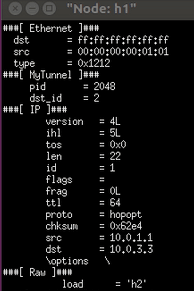Experiment 8: data plane programming practice - P4
1, Experimental purpose
- Master P4 under V1Model framework_ 16 program structure and basic syntax
- Be able to use P4 for simple data plane programming
2, Experimental environment
- Download the virtual machine software Oracle VisualBox or VMware;
- Install Ubuntu 16.04 Desktop amd64 in the virtual machine, and install the complete Mininet and P4 development environment;
- Provide P4 image P4-Suite2018.ova, extraction code: egwf
3, Experimental requirements
Learn the P4 official sample tutorial, link: https://github.com/p4lang/tutorials , understand the basic syntax of P4-16 version and the P4 code structure based on V1Model, and complete the following exercises:
(1) Basic requirements
-
Be familiar with the basic forwarding principle of switch IPV4 using P4, write P4 program, and realize IPV4 tunnel forwarding in the following topology.

-
Supplement basic in P4 tutorial_ tunnel.p4
/* -*- P4_16 -*- */
#include <core.p4>
#include <v1model.p4>
const bit<16> TYPE_MYTUNNEL = 0x1212;
const bit<16> TYPE_IPV4 = 0x800;
/*************************************************************************
*********************** H E A D E R S ***********************************
*************************************************************************/
typedef bit<9> egressSpec_t;
typedef bit<48> macAddr_t;
typedef bit<32> ip4Addr_t;
header ethernet_t {
macAddr_t dstAddr;
macAddr_t srcAddr;
bit<16> etherType;
}
header myTunnel_t {
bit<16> proto_id;
bit<16> dst_id;
}
header ipv4_t {
bit<4> version;
bit<4> ihl;
bit<8> diffserv;
bit<16> totalLen;
bit<16> identification;
bit<3> flags;
bit<13> fragOffset;
bit<8> ttl;
bit<8> protocol;
bit<16> hdrChecksum;
ip4Addr_t srcAddr;
ip4Addr_t dstAddr;
}
struct metadata {
/* empty */
}
struct headers {
ethernet_t ethernet;
myTunnel_t myTunnel;
ipv4_t ipv4;
}
/*************************************************************************
*********************** P A R S E R ***********************************
*************************************************************************/
parser MyParser(packet_in packet,
out headers hdr,
inout metadata meta,
inout standard_metadata_t standard_metadata) {
state start {
transition parse_ethernet;
}
state parse_ethernet {
packet.extract(hdr.ethernet);
transition select(hdr.ethernet.etherType) {
TYPE_MYTUNNEL: parse_myTunnel;
TYPE_IPV4: parse_ipv4;
default: accept;
}
}
state parse_myTunnel {
packet.extract(hdr.myTunnel);
transition select(hdr.myTunnel.proto_id) {
TYPE_IPV4: parse_ipv4;
default: accept;
}
}
state parse_ipv4 {
packet.extract(hdr.ipv4);
transition accept;
}
}
/*************************************************************************
************ C H E C K S U M V E R I F I C A T I O N *************
*************************************************************************/
control MyVerifyChecksum(inout headers hdr, inout metadata meta) {
apply { }
}
/*************************************************************************
************** I N G R E S S P R O C E S S I N G *******************
*************************************************************************/
control MyIngress(inout headers hdr,
inout metadata meta,
inout standard_metadata_t standard_metadata) {
action drop() {
mark_to_drop(standard_metadata);
}
action ipv4_forward(macAddr_t dstAddr, egressSpec_t port) {
standard_metadata.egress_spec = port;
hdr.ethernet.srcAddr = hdr.ethernet.dstAddr;
hdr.ethernet.dstAddr = dstAddr;
hdr.ipv4.ttl = hdr.ipv4.ttl - 1;
}
table ipv4_lpm {
key = {
hdr.ipv4.dstAddr: lpm;
}
actions = {
ipv4_forward;
drop;
NoAction;
}
size = 1024;
default_action = drop();
}
action myTunnel_forward(egressSpec_t port) {
standard_metadata.egress_spec = port;
}
table myTunnel_exact {
key = {
hdr.myTunnel.dst_id: exact;
}
actions = {
myTunnel_forward;
drop;
}
size = 1024;
default_action = drop();
}
apply {
if (hdr.ipv4.isValid() && !hdr.myTunnel.isValid()) {
// Process only non-tunneled IPv4 packets
ipv4_lpm.apply();
}
if (hdr.myTunnel.isValid()) {
// process tunneled packets
myTunnel_exact.apply();
}
}
}
/*************************************************************************
**************** E G R E S S P R O C E S S I N G *******************
*************************************************************************/
control MyEgress(inout headers hdr,
inout metadata meta,
inout standard_metadata_t standard_metadata) {
apply { }
}
/*************************************************************************
************* C H E C K S U M C O M P U T A T I O N **************
*************************************************************************/
control MyComputeChecksum(inout headers hdr, inout metadata meta) {
apply {
update_checksum(
hdr.ipv4.isValid(),
{ hdr.ipv4.version,
hdr.ipv4.ihl,
hdr.ipv4.diffserv,
hdr.ipv4.totalLen,
hdr.ipv4.identification,
hdr.ipv4.flags,
hdr.ipv4.fragOffset,
hdr.ipv4.ttl,
hdr.ipv4.protocol,
hdr.ipv4.srcAddr,
hdr.ipv4.dstAddr },
hdr.ipv4.hdrChecksum,
HashAlgorithm.csum16);
}
}
/*************************************************************************
*********************** D E P A R S E R *******************************
*************************************************************************/
control MyDeparser(packet_out packet, in headers hdr) {
apply {
packet.emit(hdr.ethernet);
packet.emit(hdr.myTunnel);
packet.emit(hdr.ipv4);
}
}
/*************************************************************************
*********************** S W I T C H *******************************
*************************************************************************/
V1Switch(
MyParser(),
MyVerifyChecksum(),
MyIngress(),
MyEgress(),
MyComputeChecksum(),
MyDeparser()
) main;
-
make run compiles and runs the above program

-
Enter xterm h1 h2 in mininet and. / receive.py in h2 to start the server to receive messages

Start sending packets to h2 and h3 when running on the h1 command line
Tunnel not used
- Enter / send.py 10.0.2.2 "h2" on the h1 command line. Tunnel forwarding is not used. h1 sends a message to h2 and h3 cannot receive it


- Enter. / send.py 10.0.3.3 "h3" on the h1 command line. Tunnel forwarding is not used. h1 sends a message to h3, but h2 cannot receive it


Use tunnel
- On the h1 command line, enter. / send.py 10.0.3.3 "h2" --dst_id 2 adopts tunnel forwarding. Although the IP is changed, the switch still sends the message to h2 after tunnel forwarding


It can be found that after using tunneling technology, packets can ignore the destination ip address and according to dst_id delivery
4, Personal experience
- This experiment is difficult, mainly in basic_ Completion of tunnel.p4 code. Some problems were encountered when completing the code, which were solved after consulting the students.
- Through this experiment, we understand P4 under the V1Model framework_ 16 program structure and basic syntax, can simply use P4 for simple data plane programming, so as to prepare for the later big homework